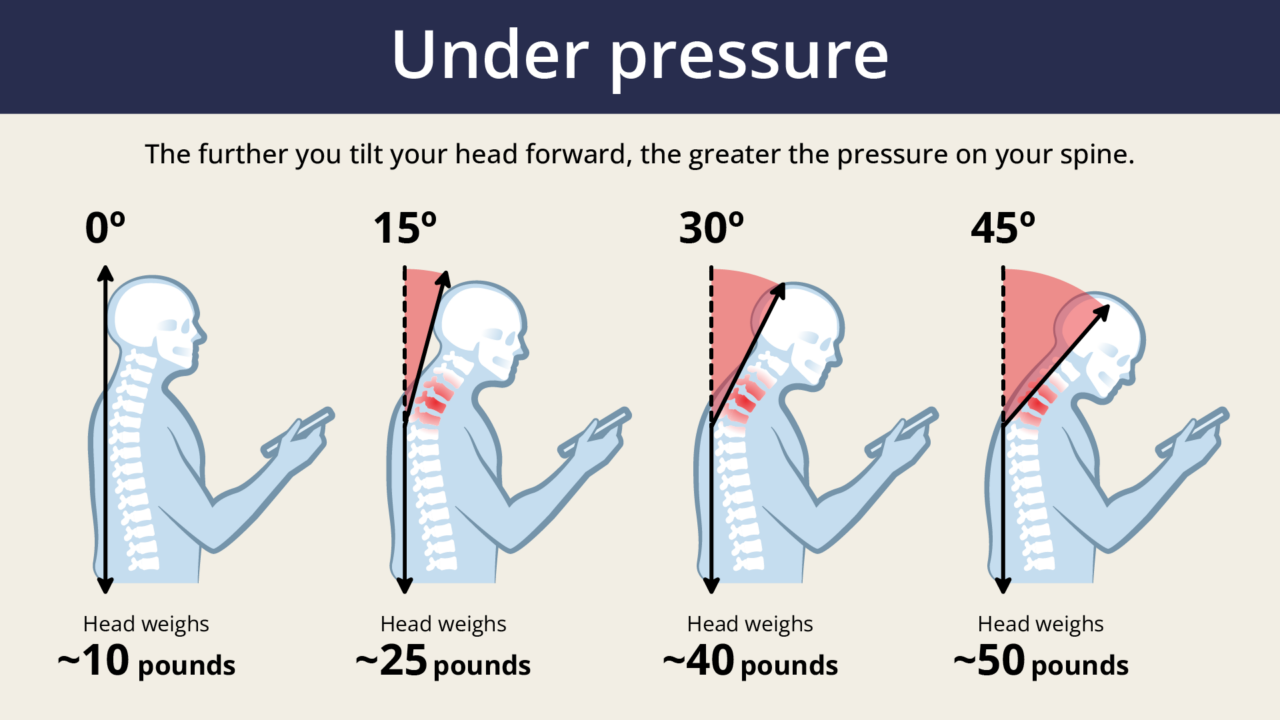Learn about how to prevent this repetitive injury.
Sometimes our tech can be a pain in the neck.
Your head weighs about 10 to 20 pounds when it’s positioned in alignment with your neck. But when it’s angled down, your head gets heavier. “Tech neck,” also called “text neck,” is a strain or injury that occurs over time from looking down at our screens.
“At about 45 degrees, the head weighs about 50 pounds,” said Dr. Heidi Chen, a physical medicine and rehabilitation physician with Vanderbilt Health. “So when we keep looking down at our technology, the muscles in our neck have to work a lot harder to hold our heads up. The longer we do these things when we’re looking down, the muscles get sore and fatigued.”

What are the symptoms of tech neck?
Symptoms of tech neck include soreness, aching and tightness in the neck and shoulders, and sometimes a headache. People with tech neck may feel stiff and experience a reduction in mobility when turning their head from side to side or up and down. “You might notice some tension or pain between your shoulder blades,” Chen added. “If it’s severe enough, you might also notice some numbness and tingling running down your arms.”
How common is tech neck?
With nearly 75% of the global population using tech devices for hours every day, tech neck is a common syndrome in both adults and kids. Researchers are even calling the issue an epidemic.
How can I prevent tech neck?
“It’s all about movement,” Chen said. “Set an alarm for yourself to take a break after 15 to 30 minutes of screen time,” Chen said. Stretching your neck and shoulders frequently can help alleviate tension and aid mobility.
“It’s all about movement. Set an alarm for yourself to take a break after 15 to 30 minutes of screen time.”
Working on your posture while using tech can also help. Often, we prioritize the comfort of our eyes over the comfort of our posture, holding our devices close and bending our neck to read. Instead, Chen recommends holding your smartphone or tablet closer to eye level to keep your head more in line with your neck. Additionally, only use your device while standing or sitting. Lying down and propping or craning the neck forward can also lead to pain. Use both hands to hold the device to avoid straining one arm and shoulder.

When working on a computer at a desk, do not sit straight up for long periods of time, which can force the muscles in the neck to contract in order to support the head. Instead, choose an ergonomic chair with good lumbar support that can recline slightly. “By reclining even 25 degrees, your neck is having to do less work to hold up your head,” Chen said.
Alternatively, consider a standing desk, or one that converts from a seated position to a standing position, to avoid long periods of sitting.
Why is preventing tech neck important?
The condition may cause more than just neck and shoulder pain. People with tech neck also report low back pain, pain in their arms, eye strain, irritability from discomfort, anxiety and issues with work or school productivity or performance.
Additionally, some research indicates tech neck is associated with heart and lung concerns. Looking down restricts muscles in the ribcage area, which could impede breathing.
Talk to your kids about preventing tech neck, too. Many children are spending five to seven hours a day using tech devices. Good posture and tech-use practices can help prevent the development of chronic pain as they get older. Parents can also model good practices to their kids.
When do I need to see a doctor?
If you’re still experiencing pain after you’ve made changes to your posture and are being more mindful of how much you’re using tech, talk to your doctor, Chen said. Your health care provider can help you find solutions.

Personalized spine care
Vanderbilt Spine Center specialists work together to find the best treatment for each patient and to give the expert care and support each deserves. They deliver innovative non-surgical and surgical treatments for back and neck pain, sciatica and other spine conditions.




